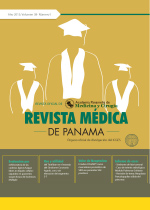Lecciones desde el epicentro occidental de la pandemia: la experiencia de Montefiore Health System en el manejo de pacientes infectados con COVID19 en la ciudad de Nueva York
Autores/as
DOI:
https://doi.org/10.37980/im.journal.rmdp.2020881Resumen
[Lessons learned from the pandemic’s Western epicenter: the experience of Montefiore Health System in the management of patients infected with COVID19 in New York City]
ResumenMontefiore Health System, red de hospitales universitarios afiliados al Albert Einstein College of Medicine, ha sido uno de los principales frentes de batalla contra el COVID-19 en la ciudad de Nueva York, epicentro occidental de la pandemia. Con múltiples campus localizados principalmente en el Bronx, donde la tasa de infección por COVID-19 es de 2,048/100,000 habitantes, ha tenido que enfrentar la pandemia desde sus inicios. La experiencia acumulada a lo largo de estos meses es invaluable, aunque desafortunadamente gran parte de ella ha sido adquirida en base a ensayo y error, dada la novedad de este virus y la ausencia de guías de manejo basadas en la evidencia. Nuestra experiencia es también relevante ya que el 35% de nuestra población es de raza Hispana. En las siguientes páginas repasamos aquello que sabemos sobre los inicios del SARS-CoV-2, las tesis más aceptadas acerca de su fisiopatología, su curso clínico, el manejo inicial una vez el paciente es admitido a nuestra institución con el diagnóstico de COVID-19. También exponemos nuestras experiencias en el manejo terapéutico de las complicaciones multiorgánicas que provoca esta entidad.
Abstract
Montefiore Health System, a network of university hospitals affiliated with the Albert Einstein College of Medicine, has been one of the main fronts in the battle against COVID-19 in New York City, western epicenter of the pandemic. With multiple campuses located mainly in The Bronx, where the rate of infection is of 2,048/100,000 inhabitants, it had to fight the pandemic since its very beginning. The experience gained during these past months is invaluable, although unfortunately most of it had to be learned by trial and error, given the novelty of this coronavirus and the complete lack of evidence-based guidelines. Our experience is particularly relevant given that 35% of our patient population is of Hispanic heritage. In the next few pages, we’ll go over what we currently know about the beginnings of SARS-CoV-2, the currently accepted hypothesis about its pathogenesis, its clinical course, and its initial management once a COVID+ patient is admitted to our institution. We also share our experiences with the clinical management of the multiorgan complications caused by this disease.
Publicado
Número
Sección
Licencia
Derechos autoriales y de reproducibilidad. La Revista Médica de Panama es un ente académico, sin fines de lucro, que forma parte de la Academia Panameña de Medicina y Cirugía. Sus publicaciones son de tipo acceso gratuito de su contenido para uso individual y académico, sin restricción. Los derechos autoriales de cada artículo son retenidos por sus autores. Al Publicar en la Revista, el autor otorga Licencia permanente, exclusiva, e irrevocable a la Sociedad para la edición del manuscrito, y otorga a la empresa editorial, Infomedic International Licencia de uso de distribución, indexación y comercial exclusiva, permanente e irrevocable de su contenido y para la generación de productos y servicios derivados del mismo. En caso que el autor obtenga la licencia CC BY, el artículo y sus derivados son de libre acceso y distribución.






